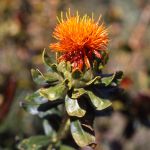| Common Name: |
False Saffron |
| Other Names: |
Safflower, saffron thistle |
| Botanical Name: |
Carthamus tinctorius |
| Genus: |
Carthamus |
| Family: |
Asteraceae |
| Native Location: |
Asia, Mediterranean regions |
| Cultivation: |
Light, well-drained soil in sun. |
| Propagation: |
By seed sown in spring at 10-15°C (50-59°F) |
| Harvest: |
Flower heads are harvested in summer and used fresh or dried for infusions. Alternatively, florets are carefully picked from fully opened flowers, leaving ovaries to develop into seeds for oil extraction. Flowers keep for one year only. |
| Variations: |
Lasting White
Has cream flowers
Orange Ball
Has orange flowers. |
| Height: |
30-60cm (12-24in) |
| Width: |
30cm (12in) |
| Hardiness: |
Hardy |
| Parts Used: |
Flowers (hong hua), seeds, oil |
| Properties: |
A bitter, aromatic herb that stimulates the circulation, heart and uterus, reducing fevers and inflammation, relieving pain, and lowering cholesterol levels. |
| Medicinal Uses: |
Internally for coronary artery disease, menstrual and menopausal problems, jaundice, and measels (flower). Not given to pregnant women. Externally for bruising, sprains, skin inflammations, wounds, and painful or paralyzed joints. (flower). |
| Culinary Uses: |
Oil is used in cooking and as part of cholesterol-reducing diets. |
| Economic Uses: |
Flowers are a source of red and yellow dyes used to color dairy products, liqueurs, and candy. Seeds are edible and can be used to coagulate milk. Oil is used to make margarine. |
| Bibliography: |
Encyclopedia of Herbs by Deni Brown Copyright © 1995, 2001 Dorling Kindersley Limited Pg 157 |
